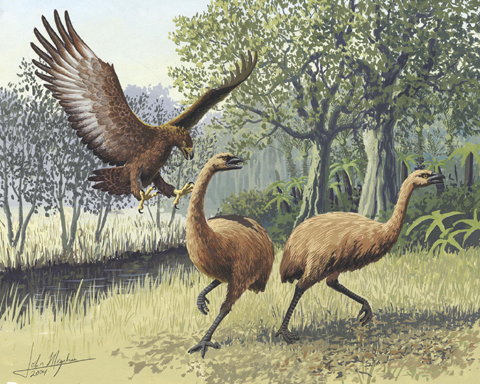Prize beast: our tiger of the sky
The bones of our almighty moa-eating eagle – the now extinct Haast Eagle – have recently been found in Malborough giving archaeologists a fresh new set of questions to ponder.
When the first Haast eagle bones were discovered in 1871 in Glenmark Swamp in Canterbury, the questions flowed, however since then three complete skeletons have been unearthed allowing archaeologists to build a picture of what was once our top predator.
Artistic impressions, sculptures, animated films & dramatic dioramas soon followed helping to fill the imaginary gap, so to speak.
The size of a hang-glider, with talons akin to a tiger’s and formidable leg muscles, the Haast eagle was the largest and most powerful eagle ever known.
Perched at the top of the food chain, it was unique amongst eagles in that it was free to take on prey much, much larger than itself, because there was no need to carry it to safer climes.
Evidence suggests that it would lay in wait on forest branches until prey – such as the moa – stumbled into its path.
Rocketing down at speeds of up to 80km per hour, the eagle would knock moa from its feet and pierce its neck & skull with its powerful talons.
Given that it could take on 180kg birds, it is not unfeasible to imagine these fearsome birds snacking on humans too.
Oral histories speak of these magnificent birds of prey devouring men, women & children, so it’s surprising to see that our very own ‘monster’ seems to be completely absent from our folklore & storybooks.
I’m not one to demonise certain animals, but rest assured, give me a playground of kids & I’d quickly seed this grisly tale into their imaginations in an attempt to open a window onto our pre-historic land.
Most cultures have a beastie of sorts, and from what I can tell, all of ours have been borrowed – the grizzly bear, wolves, lions. The Haast eagle would be well cast, given that the closest thing it has in competition is our docile giant weta. Puh.
P.S Les Anderson from Archive Birds NZ has kindly given us an audio reconstruction of what the Haast’s Eagle would have sounded like. The construction was created by sourcing audio clips of the nearest living relatives & feeding them into a computer along with other data on the structure of the vocal organs. Have a listen here –

